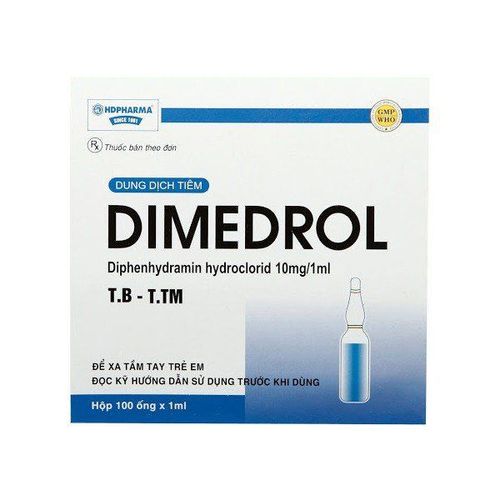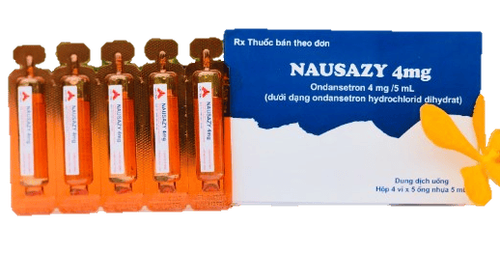This is an automatically translated article.
Hydroxyzine is an H1 antihistamine used in the treatment of itching, antiemetics or to calm nerves. However, the use of this product requires certain guidelines to ensure its safety and effectiveness.
1. What is Hydroxyzine?
Hydroxyzine is a product belonging to the group of antihistamines, antiemetics, antipruritic drugs. Hydroxyzine medicine is prepared with many different forms and strengths:
Capsules: 25mg, 50mg, 100mg; Suspension: 25mg/5ml; Syrup: 10mg/5ml; Tablets: 10mg, 25mg, 50mg, 100mg; Injections: 25 mg/ml, 50 mg/ml.
2. Indications and contraindications of the drug Hydroxyzine
Hydroxyzine is used for the following purposes:
Anti-itch; Anti-vomiting; Anti motion sickness; Nerve calming; Used for anxiety cases, need sedation before and after surgery; Management of agitated mental states in acute alcohol withdrawal syndrome. Some cases are contraindicated to use Hydroxyzine:
Hypersensitivity or allergy to the active ingredient Hydroxyzine or any ingredient in the drug; Pregnant women and nursing mothers should not take Hydroxyzine; This product is contraindicated for intravenous, arterial or subcutaneous administration; Hydroxyzine is contraindicated in patients with prolonged QT interval.
3. Instructions for using Hydroxyzine HCL 25mg
Specific dose of Hydroxyzine drug is as follows:
3.1. Anti-itching Adults and children over 12 years: The recommended dose of Hydroxyzine is 25mg/time taken in the evening, can be increased to 25mg/time, taken 3-4 times daily if necessary; Children 6 months to 6 years old: It is recommended to use Hydroxyzine at a dose of 5-15mg / time in the evening, can increase to 50 mg / day divided into 3-4 times orally if necessary; Children 6 - 12 years old: Take Hydroxyzine 15-25mg once in the evening, can increase to 50-100mg/day divided into 3-4 times if necessary. Or the dose of Hydroxyzine can be calculated by weight in children such as taking 1 mg/kg/day, divided into several times, increasing to a maximum of 2.5 mg/kg/day for children from 1 to 6 years old or up to 2 mg/kg /day for children over 6 years old. 3.2. Antiemetic (except for nausea and vomiting caused by pregnancy): Adults: Intramuscular Hydroxyzine 25-100mg/time; Children: Intramuscular injection at a dose of 1.1 mg/kg/time; Subsequent doses should be adjusted according to the patient's response. 3.3. Anti-anxiety Adults: Take Hydroxyzine 25-100mg/time, 4 times/day; Children 6 years and older: Use Hydroxyzine 50-100mg/day, divided into several oral doses; Children under 6 years old: Take a dose of 50mg/day, divided into several times. 3.4. Alleviating anxiety before and after anesthesia Adults: Hydroxyzine is administered orally at a dose of 50-100mg or 25-100mg intramuscularly; Children: 0.6 mg/kg orally or 1.1 mg/kg intramuscularly. 3.5. Control of agitation due to alcohol withdrawal Adults: Hydroxyzine 50-100 mg intramuscularly, repeated every 6 hours if necessary; 3.6. Dosage of Hydroxyzine for some other subjects: Liver failure: Need to reduce 1⁄3 daily dose of Hydroxyzine compared to normal people; Renal impairment : Adjust down 1⁄2 from daily dose; Elderly: Hydroxyzine should be initiated at a dose lower than the lower limit of the recommended adult dose range, possibly 10 mg/time, 3-4 times/day, may be increased to 25 mg/time , 3-4 times a day if necessary. Some notes on the use of Hydroxyzine:
Hydroxyzine is prepared in the form of Hydrochloride and Pamoat (Embonate) salts. For oral administration, it will be calculated in the form of Hydrochloride salt, every 170mg of Hydroxyzine Pamoate is equivalent to 100mg of Hydroxyzine hydrochloride; Patients should be prescribed oral Hydroxyzine instead of intramuscular injection as soon as possible; The lowest effective dose of Hydroxyzine should be used; Hydroxyzine HCL 25 mg can be injected intramuscularly, however, it can cause pain, irritation at the injection site, abscess, edema, tissue necrosis; When injecting Hydroxyzine intramuscularly in adults, attention should be paid to the injection site 1⁄4 deep on the outside of the gluteal muscle or the medial side of the thigh. Care should be taken when administering intramuscular injection in the deltoid region and only when the muscle mass in this region is well developed to limit damage to the radial nerve. Absolutely do not inject Hydroxyzine intramuscularly into the lower and middle 1⁄3 of the arm; In children, the site of intramuscular injection of Hydroxyzine is the mid-lateral thigh muscle. Young children only inject into the outer edge of the lateral upper quadrant when required (eg, children with burns) to minimize the risk of sciatic nerve damage. Note: Symptoms of Hydroxyzine overdose include convulsions, gloom, hypotension, severe drowsiness, nausea, vomiting, uncontrolled muscle movements or possibly QT prolongation. There is currently no specific treatment for an overdose of antihistamines such as Hydroxyzine. The mainstay of treatment is the immediate elimination of the drug from the stomach by induction of vomiting or gastric lavage. For people who are comatose, have convulsions or have lost their vomiting reflex, a balloon endotracheal tube can be inserted to prevent gastric juice from refluxing into the respiratory tract. Patients with low blood pressure can be prescribed intravenous fluids and use Noradrenalin or Metaraminol (without adrenaline).
4. Hydroxyzine side effects
Common side effects of Hydroxyzine:
Mild to moderate drowsiness; Thickening of bronchial secretions; Headache, fatigue, restlessness, dizziness; Increased appetite, weight gain; Nausea, diarrhea, abdominal pain; Dry mouth; Athritis; Sore throat . Some uncommon side effects of Hydroxyzine :
Anxiety, palpitations; Lower blood pressure; Edema; Depression, lethargy or paradoxical arousal; Angioedema, rash; urinary retention; Hepatitis; Myalgia, tremor, paresthesia; Blurred vision; Bronchospasm;
5. Some notes when using Hydroxyzine drug
Hydroxyzine should not be used by subcutaneous, arterial or intravenous injection because extravasation can cause aseptic abscess and marked tissue hardening.
Hydroxyzine should be used with caution in patients with narrow-angle glaucoma, prostate enlargement, bladder neck obstruction, bronchial asthma or chronic obstructive pulmonary disease.
The anticholinergic effects of Hydroxyzine are not well tolerated in the elderly. Therefore, hydroxyzine should only be used for short-term anti-itch purposes and should not be used for the purpose of calming nerves.
Hydroxyzine should be used with caution in patients with risk factors for QT prolongation such as congenital long QT syndrome, family history of long QT syndrome, other conditions predisposing to QT prolongation, disorders ventricular arrhythmias, myocardial infarction, decompensated heart failure and arrhythmia... At the same time, special caution should be exercised when co-administered with other drugs that prolong the QT interval.
The level of safety of Hydroxyzine during pregnancy is classified in group C. Studies have shown that Hydroxyzine can be teratogenic in mice, rats and rabbits... when used at doses much higher than that of therapeutic dose for humans. Pending further safety data in pregnancy, Hydroxyzine is contraindicated in this population.
It is not known whether Hydroxyzine is distributed into breast milk, therefore this product is not indicated for use by nursing mothers.
Hydroxyzine may cause drowsiness, potentially reducing mental alertness or physical coordination. Therefore, users of Hydroxyzine should avoid driving or operating machinery.
6. Pharmacological characteristics of the drug Hydroxyzine
6.1. Pharmacodynamics Hydroxyzine is a competitive histamine H1-receptor antagonist. In addition to antihistamine effects, Hydroxyzine also has central nervous system depressant, anticholinergic, antispasmodic and local anesthetic effects. Hydroxyzine also has a calming effect, antiemetic and can especially cause respiratory depression (common in young children).
Hydroxyzine does not cause cortical inhibition, and the mechanism of antiemetic and anti-motion sickness of Hydroxyzine is unknown. It is hypothesized that antiemetics are due to anticholinergic and CNS depressant effects.
Hydroxyzine has the ability to slightly reduce gastrointestinal secretion and antispasmodic. The antispasmodic drugs of Hydroxyzine antagonize the spasmodic mechanism of substances such as Acetylcholine, Histamine or Serotonin.
6.2. Pharmacokinetics Absorption: Hydroxyzine is rapidly absorbed from the gastrointestinal tract after oral administration, taking effect after about 15 - 30 minutes with oral administration and faster than intramuscular injection. Hydroxyzine Tmax is about 2 hours, lasting 4-6 hours after a single dose. Hydroxyzine inhibits up to 4 days of allergic reactions (eg, urticaria, erythema) and pruritus following an intradermal test to allergens and histamine.
Distribution: After absorption, Hydroxyzine is widely distributed to most body tissues and fluids. Highest concentrations in liver, lung, spleen, kidney, adipose tissue.
Metabolism: Hydroxyzine is metabolised in the liver by CYP3A4 and CYP3A5 by an unknown mechanism. Hydroxyzine appears to be completely and primarily metabolized in the liver to the metabolite carboxylic acid (also known as Cetirizine), a long-acting antihistamine.
Elimination: Hydroxyzine and its metabolites are eliminated in the feces via bile. The half-life is approximately 20 hours in adults, 29 hours in the elderly and 37 hours in patients with hepatic impairment.
7. Hydroxyzine drug interactions
Hydroxyzine may have an additive effect or enhance the effect of other CNS depressants such as opioids, analgesics, barbiturates, other sedatives, anesthetics, anesthetics or alcohol. .. which in turn leads to excessive neurosedation.
When Hydroxyzine is used together with other Acetylcholine antagonists, the anti-Acetylcholine effect may be increased.
Hydroxyzine inhibits and reverses the vasoconstrictor effect of Epinephrine (Adrenalin), so in case a vasoconstrictor must be used for patients taking Hydroxyzine, it is preferable to use Noradrenalin or Metaraminol.
The effect of Hydroxyzine can be increased when combined with Droperidol, Methotrimeprazine, Pramlintide.
The effects of Hydroxyzine may be reduced when taken with Amphetamine, acetylcholinesterase inhibitors.
Hydroxyzine intramuscular injection is incompatible when mixed with Aminophyllin, Amobarbital, Doxorubicin, Chloramphenicol sodium succinate, Dimenhydrinate, heparin, Penicillin G, Pentobarbital, Phenobarbital, Phenytoin, Ranitidine, Sulfisoxazole, vitamin B combined with vitamin C, and Haloperidol lactate.
Please dial HOTLINE for more information or register for an appointment HERE. Download MyVinmec app to make appointments faster and to manage your bookings easily.













